Welcome to the heart of North Carolina, where the rolling hills meet vibrant green landscapes. Homeowners here know that a lush, well-maintained lawn isn’t just a matter of pride; it’s a canvas that reflects the beauty of our region. But let’s be honest, achieving that picture-perfect cut grass isn’t always as straightforward as it seems, especially with our unique climate and soil types.
Today, we’re here to walk you through the essentials of lawn care, tailored specifically for our Piedmont area. Whether you’re a seasoned green thumb or a first-time homeowner looking to transform your yard, this guide is your go-to resource.
We’ll dive into everything from choosing the right grass type for our temperate climate to mastering the art of mowing, watering, and fertilizing like pros. So, let’s grab our gardening gloves and get started.
We’ll help you turn your lawn into a lush, vibrant oasis that is the envy of the neighborhood. Ready? Let’s dig in!
Understanding Your Grass Type
Navigating the world of grass types in the Piedmont area can feel a bit like a botanical safari. We’ve got a variety of grasses that not only thrive in our climate but also cater to the diverse aesthetics and functionalities we desire in our lawns.
Let’s break down the most common contenders, shall we?
Tall Fescue
First up, Tall Fescue. This grass is like the reliable friend we all wish we had – resilient, adaptable, and always looks good. It’s perfect for our sometimes unpredictable Piedmont weather, handling both the heat and occasional cold snaps with grace.
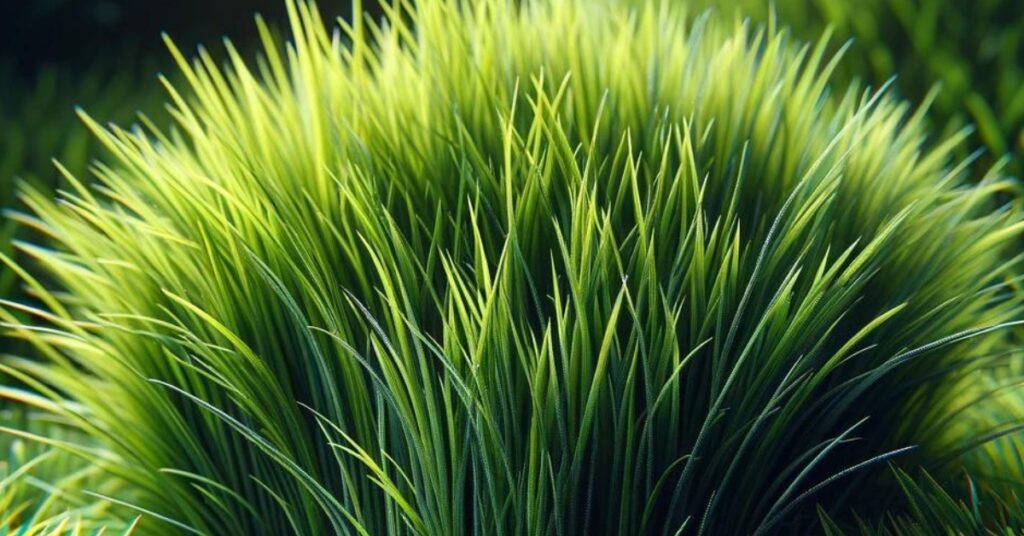
If you’re looking for a grass type that offers a lush, green look with minimal fuss, Tall Fescue might just be your lawn soulmate.
Bermuda Grass
Then there’s Bermuda grass. Think of Bermuda as the sun-loving, high-energy friend in the group. It thrives in the heat, making it a great choice for those scorching Piedmont summers.
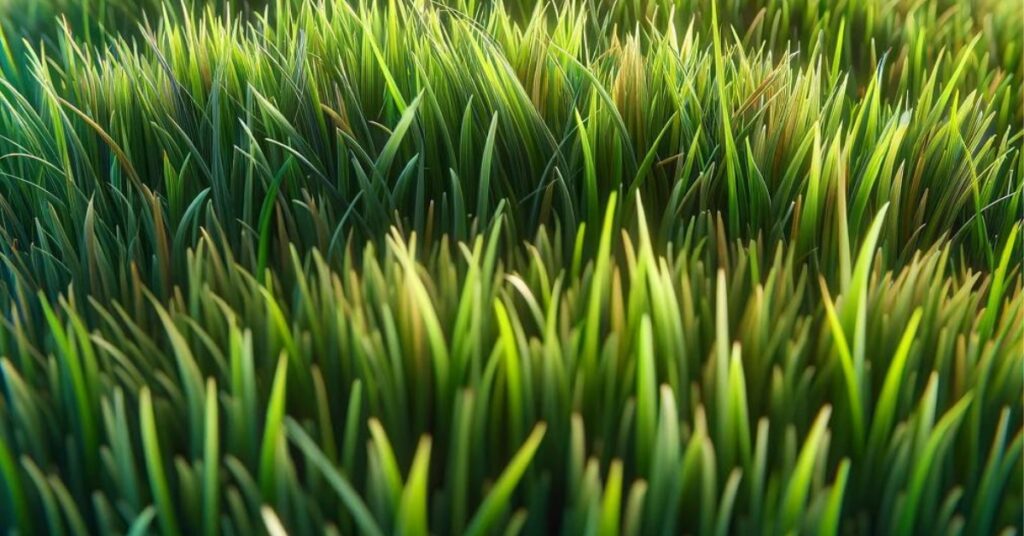
Bermuda grass is all about full sun exposure and doesn’t take kindly to shade. So, if your yard is a sunbather’s dream, Bermuda could be the perfect fit.
Zoysiagrass
Zoysiagrass is like the lawn’s luxury carpet. Dense, soft, and with a fine texture, it creates a stunning visual effect. It’s drought-tolerant and has a great resistance to wear, making it ideal for high-traffic areas.
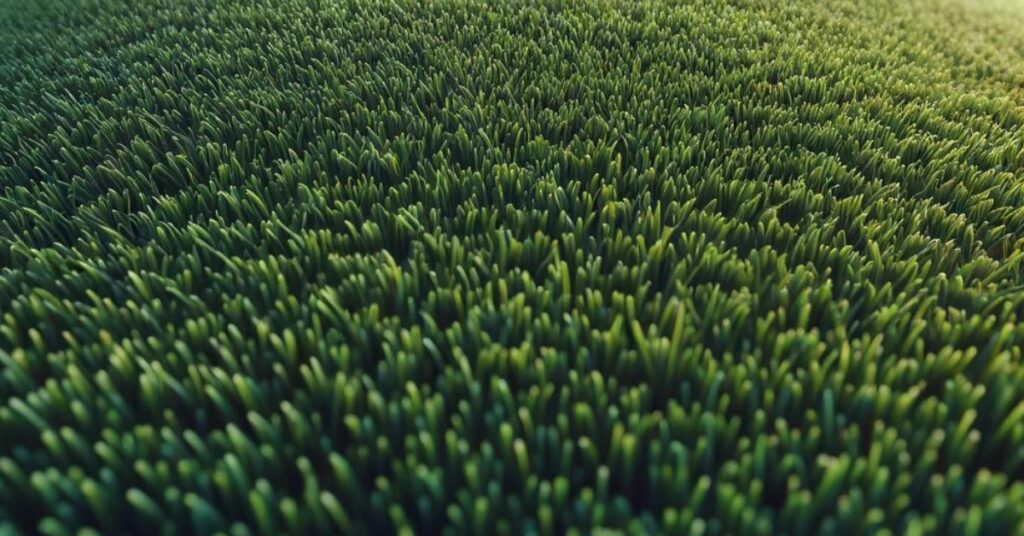
Zoysiagrass prefers sun but can tolerate light shade, offering flexibility for different yard types. It’s a slow grower, which means less mowing, but it requires patience to establish.
Centipedegrass
Think of Centipedegrass as the low-maintenance friend. It’s not demanding, making it perfect for those who prefer a “plant it and forget it” approach.
This grass has a lighter green color and grows slowly, reducing the need for frequent mowing.
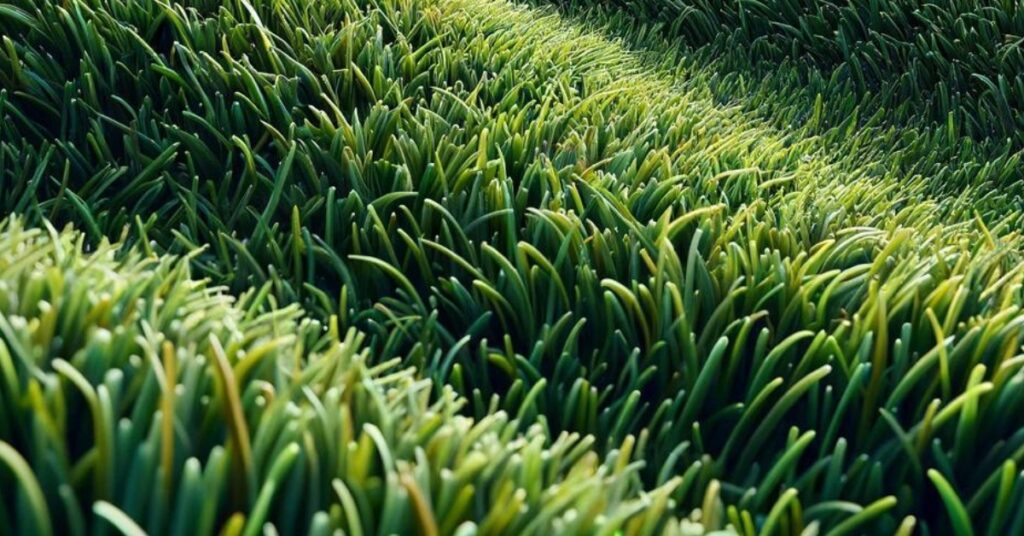
It prefers acidic soils and doesn’t need a lot of fertilizer, making it cost-effective. However, it’s not as cold-tolerant as some other types, so it’s best suited for the warmer parts of the Piedmont.
St. Augustine Grass
St. Augustinegrass is this group’s shade lover. It thrives in both sun and shade, making it a versatile choice for varied landscapes. With its broad, flat blades, it creates a dense lawn that feels lush underfoot.

It’s particularly good at crowding out weeds, thanks to its aggressive growth. However, it does require regular watering and fertilization to maintain its beauty.
Kentucky Bluegrass
Kentucky Bluegrass might bring to mind lush, northern lawns, but with the right care, it can also thrive in the Piedmont. It’s known for its beautiful blue-green color and dense growth.

This grass type prefers cooler temperatures and can struggle in the height of summer heat, so it’s often mixed with other grass types for resilience. It requires moderate maintenance, including regular watering and fertilization.
Perennial Ryegrass
Perennial Ryegrass is the sprinter of lawn grasses, establishing quickly and offering a rich green color. It’s often used for overseeding warm-season lawns to maintain a green color year-round.
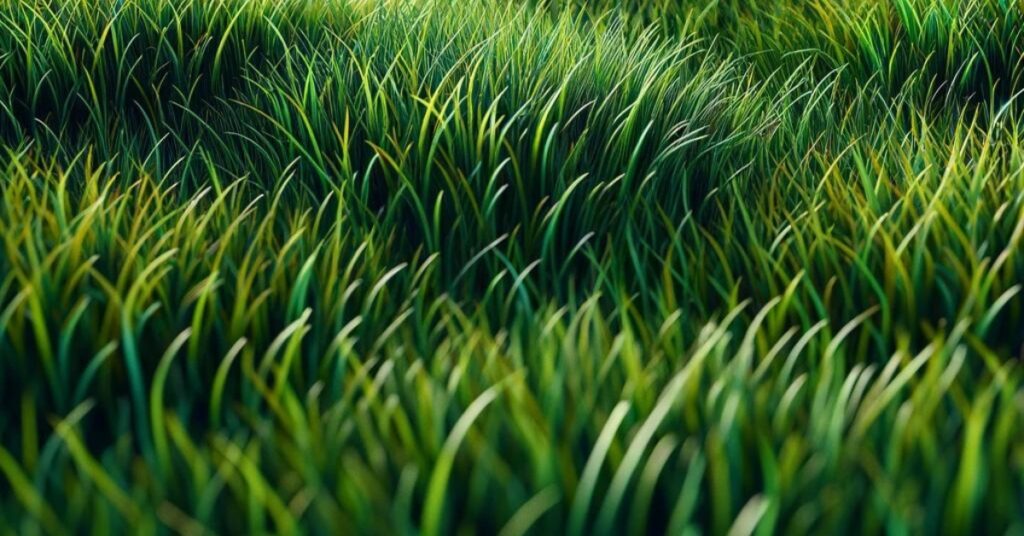
This grass is known for its fine texture and tolerance to foot traffic, making it a good choice for active yards. It prefers cooler temperatures and may need extra care during hot, dry periods.
Fine Fescue
Fine Fescue includes several species like Red, Chewings, Hard, and Sheep Fescue, each offering a fine texture and shade tolerance.
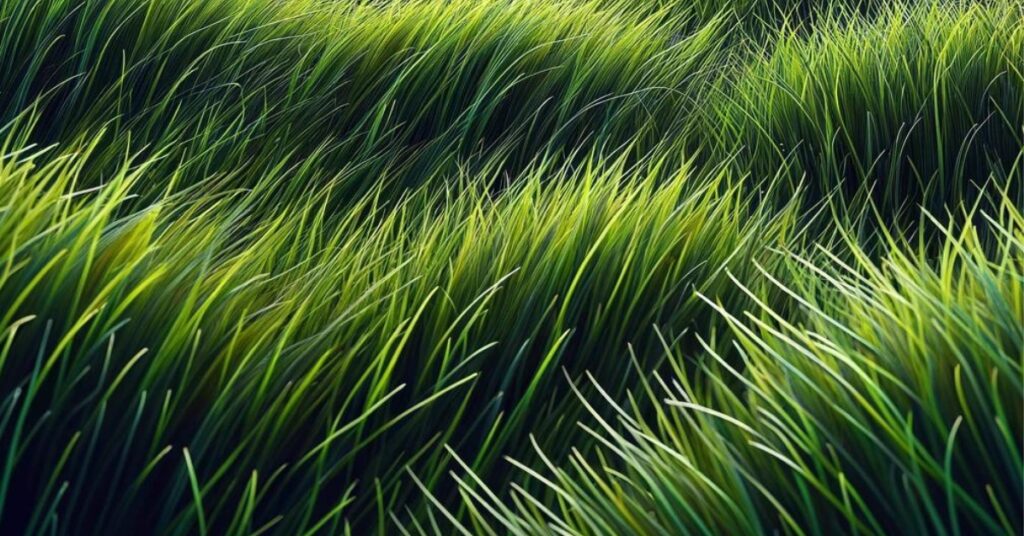
These grasses are ideal for low-maintenance lawns, as they require less fertilizer and water than many other types. They’re particularly suited for shady and dry areas where other grasses might struggle
Bahiagrass
Bahiagrass is the rugged individualist, well-suited to sandy soils common in parts of the Piedmont.
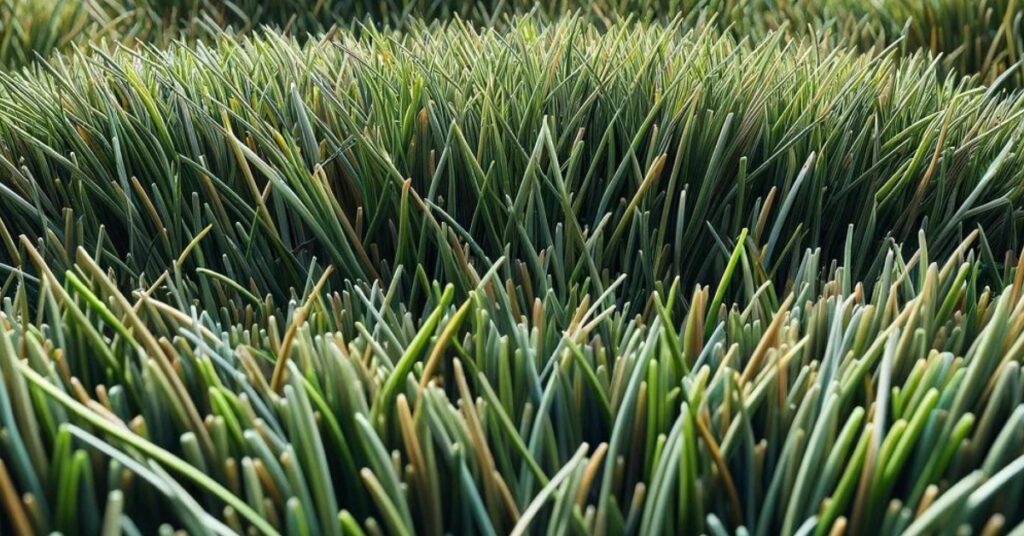
It’s drought-resistant and does well in less fertile soils, making it a good choice for more challenging landscapes. Its deep root system helps it survive in tough conditions, but it has a coarser texture and may not be the first choice for those seeking a fine, manicured lawn.
Buffalo Grass
Buffalo Grass is a native prairie grass that offers a low-maintenance option for sustainable lawns. It’s drought-tolerant, thriving in hot and dry conditions, and requires minimal mowing and fertilization.

Its fine texture and soft blue-green color make it an attractive option for eco-friendly lawns, though it’s best suited for areas with full sun.
Summing Up Grass Types
Each of these grass types brings something special to the table, and choosing the right one for your Piedmont lawn depends on your specific needs, soil type, and the amount of sun and shade your yard receives.
Whether you’re looking for low maintenance, drought tolerance, or a lush, green carpet, there’s a grass type that’s perfect for your outdoor space. With the right care and selection, your lawn can become a vibrant, healthy part of your home’s landscape.
Whether you lean towards the sturdy, cool-season friendliness of Tall Fescue or the warm-season vigor of Bermuda, knowing what works best for your specific outdoor spaces sets you up for success.
And remember, the best lawn is not just about the grass type; it’s about how well you care for it. So, let’s get ready to give your lawns the love they deserve!
Soil Preparation and Maintenance
When we talk about the foundation of a great lawn, we’re really talking about the soil beneath it. Think of your soil as the bedrock of your lawn’s health, vitality, and beauty. Whether you’re nurturing Tall Fescue, Bermuda, or any of the other grass types we’ve explored, the right soil conditions are key to your success.
Testing Your Soil
First things first, let’s get to know your soil a bit better. A simple soil test can reveal a lot about what’s going on under the surface, including pH levels and nutrient content. You might be surprised to learn how these factors can influence your lawn’s health. If you’re unsure about how to conduct a soil test, local extension services can offer easy-to-use kits and valuable advice.
Amending Your Soil
Once you have your test results, it’s time to roll up your sleeves and get to work. If your soil is too acidic or too alkaline, you’ll need to adjust it. Lime can help sweeten acidic soil, while sulfur might correct alkaline conditions. The goal is to create a neutral environment where your grass can thrive.
Aeration and Dethatching
Aeration is like giving your lawn a breath of fresh air. It involves making small holes in the soil to allow air, water, and nutrients to penetrate the grass roots. This helps the roots grow deeply and produce a stronger, more vigorous lawn.
Dethatching, on the other hand, removes the thick layer of dead plant material that can suffocate your grass. Both are essential steps for maintaining soil health and promoting robust grass growth.
The Role of Organic Matter
Incorporating organic matter into your soil can work wonders. Compost, for example, is a fantastic amendment that can improve soil structure, moisture retention, and nutrient content. Whether you’re starting a new lawn or maintaining an existing one, adding a layer of compost can give your grass the boost it needs.
Regular Maintenance
Soil care isn’t a one-and-done deal; it’s an ongoing commitment. Regularly checking your soil’s condition and making adjustments as needed will ensure your lawn remains a vibrant, healthy part of your home’s landscape.
Remember, the effort you put into your soil translates directly into the health and beauty of your grass.
The best lawn is not just about the grass type; it’s about how well you care for it. So, let’s get ready to give your lawns the love they deserve!
Mowing Techniques for a Perfect Cut
Mowing your lawn might seem like a straightforward task, but did you know that the way you mow can significantly impact the health and appearance of your grass? Let’s dive into some techniques and tips that will help you achieve that perfect cut, making your lawn the envy of the neighborhood.
The Right Mower Makes a Difference
Choosing the right lawn mower is the first step toward a healthy lawn. Whether you opt for a push mower or a riding mower, ensure it’s well-suited to the size of your lawn and the type of grass you’re growing.
Additionally, consider options like mulching mowers that redistribute grass clippings back onto the lawn, providing nutrients and acting as a natural mulch.
Keep Those Blades Sharp
Dull mower blades are one of the biggest enemies of a healthy lawn. They tear the grass rather than giving it a clean cut, which can lead to stress and disease.
Make it a habit to check and sharpen your mower’s blades regularly to ensure they’re always ready to make a precise cut. This simple step can significantly improve the health and look of your lawn.
Mowing Height Matters
Cutting your grass too short can be tempting, especially if you’re looking to reduce the frequency of mowing.
However, taller grass is generally healthier. It develops deeper roots, which helps it access water and nutrients more efficiently, reduces soil compaction, and shades the ground, keeping it cooler. This also gives other plants in the same area a better chance to thrive.
As a rule of thumb, never remove more than one-third of the grass height in a single mow to avoid putting your lawn under stress.
The Art of Mowing
When it’s time to mow, don’t just start the mower and go. Plan your pattern.
Mowing in the same direction every week can lead to soil compaction and wear patterns in the grass. Instead, alternate your mowing direction each time to encourage grass to grow more upright and reduce wear.
Additionally, if you’re using a string trimmer or weed eater for edges and hard-to-reach areas, be careful not to cut the grass too short, as this can also stress the plants.
Leave the Clippings
Unless you’re dealing with exceptionally long grass, it’s typically better to leave the clippings on the lawn. They decompose quickly, returning valuable nutrients to the soil and helping maintain moisture levels.
This practice, known as grasscycling, can reduce the need for fertilizers and save you time and effort in lawn maintenance.
Timing is Everything
The best time to mow is when the lawn is dry and the sun is not too intense.
Early evening is often ideal, as it gives the grass blades time to recover before the next day’s sun. Mowing wet grass can lead to uneven cuts and can cause clumps of clippings that smother the grass beneath.
Mowing your lawn is more than just a chore; it’s an art and a science. By following these tips, you’re not just cutting grass; you’re cultivating a living ecosystem that enhances your home’s curb appeal and provides a healthy environment for you and your family.
Remember, a little effort goes a long way in lawn care, and the rewards are well worth the time invested.
Watering Wisely: Quenching Your Lawn’s Thirst
Watering your lawn seems simple, right? Turn on the sprinkler and let it do its thing. However, when it comes to nurturing a healthy lawn, especially in the Piedmont area, how and when you water makes all the difference.
Let’s dive into some smart watering practices that ensure your lawn gets just the right amount of hydration.
First off, timing is crucial. Watering in the early morning or late evening reduces evaporation, allowing water to seep deep into the soil where roots can easily access it. This not only conserves water but also encourages deeper root growth, making your lawn more drought-resistant.
But how much is enough? Typically, lawns need about 1 inch of water per week, either from rainfall or irrigation. Use a simple rain gauge to measure how much water your lawn is receiving.
Overwatering can be just as problematic as underwatering, leading to shallow roots and fungal diseases.
Lastly, consider investing in a smart irrigation system. These systems can adjust watering based on rainfall, soil moisture, and even weather forecasts, ensuring your lawn gets exactly what it needs without waste.
By watering wisely, you’re not just maintaining your lawn; you’re fostering a resilient, vibrant green space that thrives in the Piedmont’s unique climate.
Fertilization and Weed Control: Nourishing Your Lawn
Feeding your lawn the right nutrients at the right time is like giving it a multivitamin that boosts its health, color, and growth.
In the Piedmont area, understanding the specific needs of your grass type is key to a vibrant lawn. Let’s break down how to fertilize wisely and keep those pesky weeds at bay.
Spring is the perfect time to start with a slow-release fertilizer that will nourish your lawn as it wakes up from winter.
But remember, more isn’t always better. Applying too much fertilizer can harm your lawn and the environment. Follow the recommended rates on the product label or consult with a local lawn care expert.
Weed control is another crucial aspect of lawn care. The best defense against weeds is a strong, healthy lawn that crowds out unwanted plants before they can take hold.
However, when weeds do appear, it’s important to identify them correctly so you can choose the most effective treatment, whether it’s a targeted herbicide or a natural alternative.
By focusing on tailored fertilization and proactive weed management, you’re setting the stage for a lawn that’s not only beautiful but also resilient against common challenges.
Remember, a little knowledge and care can go a long way in achieving the lush, green lawn of your dreams.
Seasonal Lawn Care Tips: Thriving Through the Year
Navigating the seasonal shifts in the Piedmont area can be a bit like a dance with nature—knowing the right steps ensures your lawn not only survives but thrives.
Let’s explore how to harmonize your lawn care routine with the rhythm of the seasons, incorporating essential practices from cutting grass to managing nutrients.
Spring: Awakening and Preparation
As the sun begins to warm the soil, it’s time to wake your lawn from its winter slumber.
Early spring is ideal for sharpening mower blades, ensuring a clean cut without damaging the grass. Dull blades can tear at grass, hindering its ability to recover and grow.
It’s also a prime time for aerating compacted soil, allowing water, air, and nutrients to reach the roots more effectively.
Consider overseeding to fill in bare spots, using a high-quality seed that matches your existing lawn species.
Summer: Maintenance and Hydration
As temperatures rise, so does the growth rate of your lawn. Regular mowing, with the blade set to leave the grass taller, helps protect the soil from drought stress by shading it from the intense sun.
Taller grass also promotes deeper root growth, enhancing drought resistance. Watering wisely during the early morning reduces evaporation and ensures water penetrates deeply.
Remember, a deep soak less frequently is more beneficial than light, frequent watering.
Fall: Strengthening and Repair
Fall is the time to fortify your lawn for the colder months ahead. Applying a fall fertilizer supports root growth and stores nutrients for winter.
It’s also the perfect season for a final mow, cutting the grass to a shorter height to prevent matting and mold growth under snow.
Removing leaves and debris keeps your lawn healthy and ready for spring.
Winter: Rest and Planning
While your lawn rests, take the time to service your lawn mower and other equipment.
Sharpening blades, changing oil, and cleaning air filters will prepare you for a smooth start come spring.
This quiet season is also ideal for planning any changes or improvements you’d like to make to your lawn or garden in the coming year.
Why Adjust to the Season?
By adjusting your lawn care practices to the changing seasons, you’re not just maintaining your lawn; you’re enhancing its health, beauty, and resilience.
Each season brings its own challenges and opportunities, but with the right approach, your lawn can remain a vibrant, welcoming space all year round.
Comprehensive Residential Lawncare
At Southern State Landscape, we recognize the value of a well-maintained lawn not just as a piece of your property but as a vital part of your home’s overall appeal and your personal sanctuary.
It’s where life unfolds, from backyard barbecues to afternoons of leisure and play. That’s why we’re committed to offering a comprehensive suite of lawn care services designed to ensure your outdoor space is not only beautiful but functional and sustainable.
Our team of seasoned professionals brings a wealth of experience and a deep understanding of the unique challenges and opportunities presented by the Piedmont area’s climate and soil conditions.
We’re dedicated to providing exceptional residential services that span the full spectrum of lawn care and landscape maintenance, ensuring your outdoor space is a source of pride and pleasure.
Here’s a glimpse into our comprehensive lawn care offerings:
- Water Erosion Solutions: We protect your property from water damage with eco-friendly solutions like French drain installations, ensuring your landscape’s beauty and integrity without compromising the environment.
- Sod Installation and Mowing Services: Say goodbye to the weekly chore of mowing. Our sod installation transforms your outdoor space into a lush, green oasis overnight. Coupled with our aeration services, we guarantee your lawn’s health and beauty for the long haul.
- Retaining Wall Installation: Beyond their practical benefits in preventing soil erosion, our retaining walls serve as stunning visual features that enhance your landscape’s aesthetic appeal.
- Manicured Green Spaces: Precision in every trim and prune is our mantra. We create and maintain pristine green spaces, ensuring every hedge, shrub, and plant bed is a testament to our commitment to excellence.
- Comprehensive Property Cleanups: From seasonal maintenance to post-storm cleanups, we handle it all. Our services are designed to keep your property safe, clean, and accessible, regardless of the season.
- Tractor Services: Our expert tilling, fertilization, and weed control services are all about fostering a vibrant, healthy landscape that thrives year-round, freeing you to enjoy your outdoor space without the backbreaking work.
Land or Lot Clearing Services: Whether you’re laying the groundwork for a new project or revitalizing an existing space, our clearing services are the first step toward realizing your vision for your outdoor space.
Get In Touch for Your Free Consultation
At Southern State Landscape, we’re not just landscapers; we’re your partners in bringing your outdoor space to life. With our comprehensive approach to residential lawn care, you can rest assured that your lawn and landscape will not only meet but exceed your expectations.
Ready to elevate your landscape? Let us transform your vision into a stunning reality, offering you the peace of mind that comes with knowing your outdoor space is cared for by experts.
Give us a call at (919) 673-3956, or reach out through our contact form to schedule your FREE consultation today. Let’s create the outdoor space of your dreams together.

